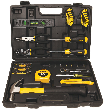What is "water-hammering"? This phrase is one that can sound pretty ominous, and can be a rather serious problem if it isn't fixed as quickly as possible. In simplest possible terms, water hammering is a phenomena that occurs when a shock wave is sent through the plumbing of your home due to the water and air interacting incorrectly when you turn the faucet off. Luckily, this is a term that refers to a very specific problem, and as such one that can be remedied rather easily.
- Locate and shut off main. The first step in being able to repair water hammering in your pipes, is to locate, and shut off the water main. Instead of turning off the water main at the street, you want to locate where the water line comes into your home. When you find that, turn the faucet control until the water is shut off (typically this is done by turning the knob clockwise).
- Empty all pipes. With the water turned off, you now need to empty out all of the pipes. This is rather simply done. Just go around your home, and turn all the water faucets on. This needs to be done in the kitchen, bathrooms, mudrooms, and anywhere you happen to have a water faucet. In addition, flush all the toilets to empty their tanks and the water lines in them as well. When you have done that, turn the faucets off. Wait a couple of minutes, and then repeat the process to ensure that all the lines are completely empty.
- Restart the water. After ensuring that all the faucets have been turned off, turn the water main back on. Go to a faucet in the uppermost section of your home, and then turn it on. Allow it to run for several minutes until all the air that is in the lines has been pushed out, and then turn the faucet off. Repeat the process for every faucet that you have in the home, as well as the toilets.
- Check your work. When you have finished restoring water to the faucets in your home, it is time to actually check the work. This can be done in a couple of ways. The first (and easiest) is to turn a faucet on all the way, and then turning it back off as quickly as possible. In addition, you can also flush your toilet a few times, running the dishwasher, or even the washing machine. If there is a repeat of the hammering, you will want to repeat the process again,
Generally speaking, this procedure should take care of the vast majority of water hammering issues. That being said, there may be times when this won't do the trick. In those situations you may need to replace the pressure control valve, or even the pipes themselves. Before you begin tackling a project like that though, you should get a second opinion from a plumber to see if they can fix the problem without having to do anything drastic.
Author Bio
Lee Wyatt
Contributor of numerous Tips.Net articles, Lee Wyatt is quickly becoming a regular "Jack of all trades." He is currently an independent contractor specializing in writing and editing. Contact him today for all of your writing and editing needs! Click here to contact. Learn more about Lee...
Toxic Table Scraps
On the average, toxic table scraps can lead to more emergency visits to the pet doctor than any other reason. Avoid the ...
Discover More
How to React During a Skid
One of scariest parts of driving is finding yourself in a skid. How you react during a skid is a combination of knowledge ...
Discover More
Paying for Multiple Kids at School
Children are great, wonderful additions to any family that help make the darkest days brighter. Unfortunately they also ...
Discover More
More Home Improvement Tips
What are Compression Faucets?
Have you ever wondered what compression faucets are? Chances are pretty good that you have wondered that at least once, ...
Discover More
Maintaining Your Septic Tank
Septic tanks are a fairly common piece of household equipment that need regular and steady maintenance. If they aren't ...
Discover More
Dealing with Low Water Pressure
Dealing with low water pressure doesn't necessarily mean that you have to hire an expensive plumber. Rather, what you ...
Discover More

Comments